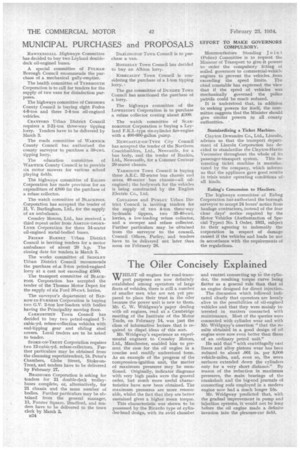The Oiler Concisely Explained
Page 38

If you've noticed an error in this article please click here to report it so we can fix it.
WHILST oil engines for road-transvv port purposes are now definitely established among operators of large fleets of vehicles, there is still a number of smaller men who are not yet prepared to place their trust in the oiler because the power unit is new to them. Mr. C., W. Wridgway's paper dealing with oil engines, read at a Cambridge meeting of the Institute of the Motor Trade, on February 14, was just the class of informative lecture that is required to dispel ideas of this sort.
Mr. Wridgwa,y's experience as experimental engineer to Crossley Motors, Ltd., Manchester, enabled him to present the case for the oil engine in a concise and readily understood form. As an example of the progress of the compression-ignition unit, the matter of maximum pressures may be mentioned. Originally, indicator diagrams with very high peaks were the general order, but much more useful characteristics have now been obtained. The maximum pressures are more reasonable, whilst the fact that they are better sustained gives a higher mean torque.
This characteristic was shown to be possessed by the Ricardo type of cylinder-head design, with its swirl chamber and ventnri connecting up 'CO the cylinder, the resulting torque curve being flatter as a general rule than that of an engine designed for direct injection.
The discussion which followed indicated clearly that operators are keenly alive to the possibilities of oibengined vehicles and that they were mainly interested in matters connected with maintenance. Most of the queries were connected with cylinder wear and with Mr. Wriclgway's assertion" that the results obtained in a good design of oil engine were now even better than those of an ordinary petrol unit."
He said that " with centrifugally cast liners and alloy pistons wear has been reduced to about .001 in. per 8,000 vehicle-miles, and, even so, the worn surfaces extended down the cylinders only for a very short distance." By reason of the reduction in maximum pressures, the main bearings of the crankshaft and the big-end journals of connecting rods employed in a modern engine now had a much longer life.
Mr. Wridgway predicted that, with the gradual improvement in pump and injection systems, it would not he long before the oil engine made a definite invasion into the pleasure-car Reid.




























































































